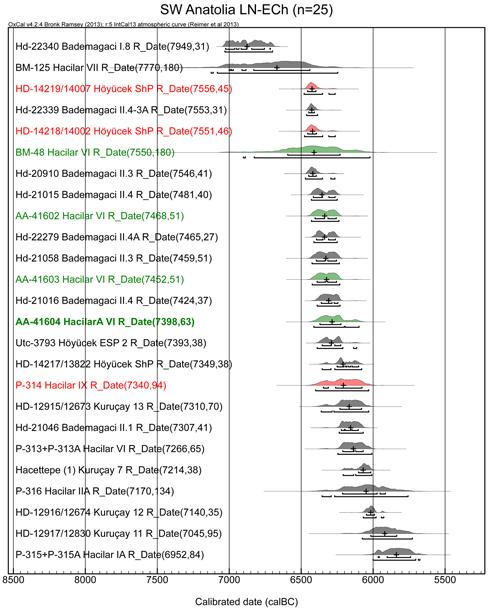 ...........................................................................................................
...........................................................................................................
Subregion Ie – Southwest Anatolia

The radiocarbon evidence of the four key sites in this subregion, Hacılar, Bademağacı, Höyücek and Kuruçay is rather consistent, apart from one famously controversial date from Hacılar (BM-127, 8700±180 BP, not included in the graph, Figure 1) and two dates in the first half of the 7th millennium cal BC from Bademağacı and Hacılar (Hd-22340 and BM-125, resp.), all standing isolated from and not fitting the current sequences.
A total of 23 remaining dates cover the Late Neolithic (i.e., the period prior to the 6000 cal BC mark), and concentrate between 6450–5990 cal BC (median values 6430–6020 cal BC) (Figure 1). Only two dates are available for the post-6000 cal BC period, usually termed the Early Chalcolithic.
The quality of the sample material is not attestable, detailed information about find circumstances and sample constitution are mostly lacking; charcoal samples are mostly unidentified. The four dates on animal bone from Kuruçay and Höyücek provide a terminus post quem (TPQ) date at best, since the bones could be curated or residual. This goes for all the dates on charcoal, which is unidentified and of unknown maturity. These can only be used as termini post quos for specific (undated) events. The samples of charred building material (posts, corner posts and (roof) beams) are also subject to the possible old-wood effect. The burned juniper post from Hacılar Level VI was first sampled by Mellaart and dated as BM-48, and subsequently by Maryanne Newton and Peter Kuniholm in three decadal samples (AA-41602–04).
The youngest sample in this series, AA-14604 (7398±63 BP), provides a good TPQ date for the construction of the building (which might be house P1, in front of which the post was found) in Level VI, Area B; put otherwise, the earliest possible time for the beginning of Level VI might be anywhere between 6370–6220 cal BC (median: 6290 cal BC). The Hacılar IX date P-314 with a younger median date at 6210 cal BC is stratigraphically incompatible with this result (but note, it is from a different area). The remaining Hacılar Level VI date P-313+P-13A provides a TPQ date between 6220–6070 cal BC (median 6140).
The two early Höyücek dates from the Shrine Phase (ShP) are stratigraphically anomalous with the Early Settlement's Phase (ESP) UtC-3793 sample, which, being on a building post, provides a TPQ date for the earliest possible time for the beginning of that level (ESP phase 2). The ensuing Höyücek ShP date Hd-14127/13822 is in agreement with the sequence.
A total of 23 remaining dates cover the Late Neolithic (i.e., the period prior to the 6000 cal BC mark), and concentrate between 6450–5990 cal BC (median values 6430–6020 cal BC) (Figure 1). Only two dates are available for the post-6000 cal BC period, usually termed the Early Chalcolithic.
The quality of the sample material is not attestable, detailed information about find circumstances and sample constitution are mostly lacking; charcoal samples are mostly unidentified. The four dates on animal bone from Kuruçay and Höyücek provide a terminus post quem (TPQ) date at best, since the bones could be curated or residual. This goes for all the dates on charcoal, which is unidentified and of unknown maturity. These can only be used as termini post quos for specific (undated) events. The samples of charred building material (posts, corner posts and (roof) beams) are also subject to the possible old-wood effect. The burned juniper post from Hacılar Level VI was first sampled by Mellaart and dated as BM-48, and subsequently by Maryanne Newton and Peter Kuniholm in three decadal samples (AA-41602–04).
The youngest sample in this series, AA-14604 (7398±63 BP), provides a good TPQ date for the construction of the building (which might be house P1, in front of which the post was found) in Level VI, Area B; put otherwise, the earliest possible time for the beginning of Level VI might be anywhere between 6370–6220 cal BC (median: 6290 cal BC). The Hacılar IX date P-314 with a younger median date at 6210 cal BC is stratigraphically incompatible with this result (but note, it is from a different area). The remaining Hacılar Level VI date P-313+P-13A provides a TPQ date between 6220–6070 cal BC (median 6140).
The two early Höyücek dates from the Shrine Phase (ShP) are stratigraphically anomalous with the Early Settlement's Phase (ESP) UtC-3793 sample, which, being on a building post, provides a TPQ date for the earliest possible time for the beginning of that level (ESP phase 2). The ensuing Höyücek ShP date Hd-14127/13822 is in agreement with the sequence.
—L.T.

Figure 1. SW Anatolian dates covering the 7th–6th millennia cal BC. Stratigraphically anomalous dates marked in red, and the single tree (Area B, burnt post) samples from Hacılar in green.



 up
up